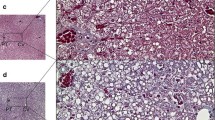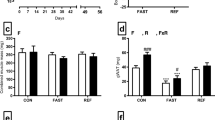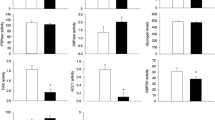Abstract
Hepatic lipidosis is a common pathological finding in the American mink (Neovison vison) and can be caused by nutritional imbalance due to obesity or rapid body weight loss. The objectives of the present study were to investigate the timeline and characterize the development of hepatic lipidosis in mink in response to 0–7 days of food deprivation and liver recovery after 28 days of re-feeding. We report here the effects on hematological and endocrine variables, body fat mobilization, the development of hepatic lipidosis and the alterations in the liver lipid classes and tissue fatty acid (FA) sums. Food deprivation resulted in the rapid mobilization of body fat, most notably visceral, causing elevated hepatosomatic index and increased liver triacylglycerol content. The increased absolute amounts of liver total phospholipids and phosphatidylcholine suggested endoplasmic reticulum stress. The hepatic lipid infiltration and the altered liver lipid profiles were associated with a significantly reduced proportion of n-3 polyunsaturated FA (PUFA) in the livers and the decrease was more evident in the females. Likewise, re-feeding of the female mink resulted in a more pronounced recovery of the liver n-3 PUFA. The rapid decrease in the n-3/n-6 PUFA ratio in response to food deprivation could trigger an inflammatory response in the liver. This could be a key contributor to the pathophysiology of fatty liver disease in mink influencing disease progression.



Similar content being viewed by others
Abbreviations
- ADR:
-
Adrenal
- ALT:
-
Alanine aminotransferase
- BMI:
-
Body mass index
- BW:
-
Body weight
- CE:
-
Cholesteryl esters
- CerPCho:
-
Sphingomyelin
- CHOL:
-
Cholesterol
- DG:
-
Diacylglycerols
- ER:
-
Endoplasmic reticulum
- FA:
-
Fatty acid
- FFA:
-
Free fatty acids
- HOMA:
-
Homeostasis model assessment
- HSI:
-
Hepatosomatic index
- MUFA:
-
Monounsaturated fatty acids
- NAFLD:
-
Non-alcoholic fatty liver disease
- P:
-
Plasma
- PL:
-
Phospholipids
- PtdCho:
-
Phosphatidylcholine
- PUFA:
-
Polyunsaturated fatty acids
- RF:
-
Re-fed
- SFA:
-
Saturated fatty acids
- T3 :
-
Triiodothyronine
- T4 :
-
Thyroxine
- TAG:
-
Triacylglycerol
- UFA:
-
Unsaturated fatty acids
- UPR:
-
Unfolded protein response
- VLDL:
-
Very-low-density lipoprotein
References
Hunter DB, Barker IK (1996) Digestive system of mink. In: Hunter DB, Lemieux N (eds) Mink… biology, health and disease. Canada Mink Breeders’ Association, University of Guelph, Graphic and Print Services, Guelph
Clausen TN, Olesen CR, Hansen O, Wamberg S (1992) Nursing sickness in lactating mink (Mustela vison). I. Epidemiological and pathological observations. Can J Vet Res 56:89–94
Schneider RR (1996) Diseases of the lactation period. In: Hunter DB, Lemieux N (eds) Mink… biology, health and disease. Canada Mink Breeders’ Association, University of Guelph, Graphic and Print Services, Guelph
Damgaard BM, Clausen TN, Henriksen P (1994) Effect of protein and fat content in feed on plasma alanine aminotransferase and hepatic fatty infiltration in mink. J Vet Med 41A:620–629
Bjornvad CR, Elnif J, Sangild PT (2004) Short-term fasting induces intra-hepatic lipid accumulation and decreases intestinal mass without reduced brush-border enzyme activity in mink (Mustela vison) small intestine. J Comp Physiol 174B:625–632
Mustonen A-M, Pyykönen T, Paakkonen T, Ryökkynen A, Asikainen J, Aho J, Mononen J, Nieminen P (2005) Adaptations to fasting in the American mink (Mustela vison): carbohydrate and lipid metabolism. Comp Biochem Physiol 140A:195–202
Rouvinen-Watt K, White MB, Campbell R (2005) Mink feeds and feeding, applied feeding guide and mink feed ingredient database. CD-ROM. Ontario Ministry of Agriculture and Food through the Agricultural Research Institute of Ontario and the Nova Scotia Agricultural College
Mustonen A-M, Nieminen P, Hyvärinen H, Asikainen J (2000) Exogenous melatonin elevates the plasma leptin and thyroxine concentrations of the mink (Mustela vison). Z Naturforsch 55C:806–813
Videla LA, Rodrigo R, Araya J, Poniachik J (2004) Oxidative stress and depletion of hepatic long-chain polyunsaturated fatty acids may contribute to non-alcoholic fatty liver disease. Free Radic Biol Med 37:1499–1507
Adams LA, Angulo P, Lindor KD (2005) Nonalcoholic fatty liver disease. Can Med Ass J 172:899–905
Rouvinen-Watt K (2003) Nursing sickness in the mink (Mustela vison)—a metabolic mystery or a familiar foe? Can J Vet Res 67:161–168
Mustonen A-M, Puukka M, Rouvinen-Watt K, Aho J, Asikainen J, Nieminen P (2009) Response to fasting in an unnaturally obese carnivore, the captive European polecat Mustela putorius. Exp Biol Med 234:1287–1295
Nieminen P, Rouvinen-Watt K, Saarela S, Mustonen A-M (2007) Fasting in the American marten (Martes americana): a physiological model of the adaptations of a lean-bodied animal. J Comp Physiol 177B:787–795
Nieminen P, Käkelä R, Pyykönen T, Mustonen A-M (2006) Selective fatty acid mobilization in the American mink (Mustela vison) during food deprivation. Comp Biochem Physiol 145B:81–93
Nieminen P, Mustonen A-M, Kärjä V, Asikainen J, Rouvinen-Watt K (2009) Fatty acid composition and development of hepatic lipidosis during food deprivation—mustelids as a potential animal model for liver steatosis. Exp Biol Med 234:278–286
Mustonen A-M, Saarela S, Pyykönen T, Nieminen P (2005) Endocrinologic adaptations to wintertime fasting in the male American mink (Mustela vison). Exp Biol Med 230:612–620
Mustonen A-M, Puukka M, Saarela S, Paakkonen T, Aho J, Nieminen P (2006) Adaptations to fasting in a terrestrial mustelid, the sable (Martes zibellina). Comp Biochem Physiol 144A:444–450
Canadian Council on Animal Care (1993) The care and use of experimental animals, vol 1. Olfert ED, Cross BM, McWilliam AA (eds). CCAC, Ottawa
Mustonen A-M, Käkelä R, Käkelä A, Pyykönen T, Aho J, Nieminen P (2007) Lipid metabolism in the adipose tissues of a carnivore, the raccoon dog, during prolonged fasting. Exp Biol Med 232:58–69
Matthews DR, Hosker JP, Rudenski AS, Naylor BA, Treacher DF, Turner RC (1985) Homeostasis model assessment: insulin resistance and β-cell function from fasting plasma glucose and insulin concentrations in man. Diabetologia 28:412–419
Folch J, Lees M, Sloane Stanley GH (1957) A simple method for the isolation and purification of total lipides from animal tissues. J Biol Chem 226:497–509
Mustonen A-M, Nieminen P, Hyvärinen H (2002) Liver and plasma lipids of spawning burbot. J Fish Biol 61:1318–1322
Nieminen P, Rouvinen-Watt K, Collins D, Grant J, Mustonen A-M (2006) Fatty acid profiles and relative mobilization during fasting in adipose tissue depots of the American marten (Martes americana). Lipids 41:231–240
Brown JH, Lasiewski RC (1972) Metabolism of weasels: the cost of being long and thin. Ecology 53:939–943
Mustonen A-M, Pyykönen T, Aho J, Nieminen P (2006) Hyperthermia and increased physical activity in the fasting American mink Mustela vison. J Exp Zool 305A:489–498
Thom MD, Harrington LA, Mcdonald DW (2004) Why are American mink sexually dimorphic? A role for niche separation. Oikos 105:525–535
Westphal SA (2008) Obesity, abdominal obesity, and insulin resistance. Clin Cornerstone 9:23–31
Smith DG, Schenk MP (2000) Dissection guide and atlas to the mink. Morton Publishing Company, Colorado
Remillard RL, Armstrong PJ, Davenport DJ (2000) Assisted feeding in hospitalized patients: enteral and parenteral nutrition. In: Hand MS, Thatcher CD, Remillard RL, Roudebush P (eds) Small animal clinical nutrition, 4th edn. Walworth Publishing Company, Mark Morris Institute, Marceline, Missouri
Powers MA, Pappas TN (1989) Physiologic approaches to the control of obesity. Ann Surg 209:255–260
MacDonald ML, Rogers QR, Morris JG (1984) Nutrition of the domestic cat, a mammalian carnivore. Ann Rev Nutr 4:521–562
Deshmukh DR, Sarnaik AP, Mukhopadhyay A, Portoles M (1991) Effect of arginine-free diet on plasma and tissue amino acids in young and adult ferrets. J Nutr Biochem 2:72–78
Damgaard BM (1998) Effects of dietary supply of arginine on urinary orotic acid excretion, growth performance and blood parameters in growing mink (Mustela vison) kits fed low-protein diets. Acta Agric Scand 48A:113–121
Roudebush P, Davenport DJ, Dimski DS (2000) Hepatobiliary disease. In: Hand MS, Thatcher CD, Remillard RL, Roudebush P (eds) Small animal clinical nutrition, 4th edn. Walworth Publishing Company, Mark Morris Institute, Marceline, Missouri
Mustonen A-M, Puukka M, Pyykönen T, Nieminen P (2005) Adaptations to fasting in the American mink (Mustela vison): nitrogen metabolism. J Comp Physiol 175B:357–363
Cornelius LM, Jacobs G (1989) Feline hepatic lipidosis. In: Kirk RW (ed) Current veterinary therapy X: small animal practice. WB Saunders, Philadelphia
Ganong WF (2005) Review of medical physiology, 22nd edn. Lange Medical Books, McGraw-Hill, New York
Elliott WH, Elliott DC (2005) Biochemistry and molecular biology, 3rd edn. Oxford University Press, New York
Maugeais C, Tietge UJF, Tsukamoto K, Glick JM, Rader DJ (2000) Hepatic apolipoprotein E expression promotes very low density lipoprotein-apolipoprotein B production in vivo in mice. J Lipid Res 41:1673–1679
Schneider RR, Hunter DB (1992) Nursing disease in the mink. Scientifur 16:239–242
Wamberg S, Clausen TN, Olesen CR, Hansen O (1992) Nursing sickness in lactating mink (Mustela vison): II. Pathophysiology and changes in body fluid composition. Can J Vet Res 56:95–101
Ott P, Clemmesen O, Larsen FS (2005) Cerebral metabolic disturbances in the brain during acute liver failure: from hyperammonemia to energy failure and proteolysis. Neurochem Int 47:13–18
Guevara M, Baccaro ME, Torre A, Gómez-Ansón B, Ríos J, Torres F, Rami L, Monté-Rubio GC, Martín-Llahí M, Arroyo V, Ginès P (2009) Hyponatremia is a risk factor of hepatic encephalopathy in patients with cirrhosis: a prospective study with time-dependent analysis. Am J Gastroenterol 104:1382–1389
Clausen TN, Hansen O (1989) Electrolytes in mink with nursing sickness. Acta Physiol Scand 136A:P9
Sriburi R, Jackowski S, Mori K, Brewer JW (2004) XBP1: a link between the unfolded protein response, lipid biosynthesis, and biogenesis of the endoplasmic reticulum. J Cell Biol 167:35–41
Özcan U, Cao Q, Yilmaz E, Lee A-H, Iwakoshi NN, Özdelen E, Tuncman G, Görgün C, Glimcher LH, Hotamisligil GS (2004) Endoplasmic reticulum stress links obesity, insulin action, and type 2 diabetes. Science 306:457–461
Hanada S, Harada M, Kumemura H, Omary MB, Koga H, Kawaguchi T, Taniguchi E, Yoshida T, Hisamoto T, Yanagimoto C, Maeyama M, Ueno T, Sata M (2007) Oxidative stress induces the endoplasmic reticulum stress and facilitates inclusion formation in cultured cells. J Hepatol 47:93–102
El-Badry AM, Graf R, Clavien PA (2007) Omega 3–Omega 6: what is right for the liver? J Hepatol 47:718–725
Hynes AM, Rouvinen-Watt K (2007) Monitoring blood glucose levels in female mink during the reproductive cycle: prevention of hyperglycemia during the nursing period. Can J Vet Res 71:241–248
Hynes AM, Rouvinen-Watt K (2007) Monitoring blood glucose levels in female mink during the reproductive cycle: effects of short-term fish oil, chromium picolinate and acetyl-salicylic acid supplementation during late lactation. Can J Vet Res 71:249–255
Acknowledgments
This study was supported by the Natural Sciences and Engineering Research Council of Canada (Discovery Grant to KRW, NSERC Undergraduate Student Research Award to CP and RC), the Canada Mink Breeders’ Association, the Nutricia Research Foundation, the Finnish Fur Breeders’ Association, the Academy of Finland (A-MM and PN), the Mink Farmer’s Research Foundation, Fur Commission USA and the Heger Company. We thank Rae MacInnis, Annette Murphy and Cindy Crossman, the staff of the Canadian Centre for Fur Animal Research, as well as Dr. Tess Astatkie, Dr. Gordon Finley, DVM, Dr. Bruce Ramsay, DVM, Lana Crewe, Jody Muise, Jennifer Dobson, Rauni Kojo and Marja-Liisa Martimo-Halmetoja for the skillful logistical support during this study.
Author information
Authors and Affiliations
Corresponding author
About this article
Cite this article
Rouvinen-Watt, K., Mustonen, AM., Conway, R. et al. Rapid Development of Fasting-Induced Hepatic Lipidosis in the American Mink (Neovison vison): Effects of Food Deprivation and Re-Alimentation on Body Fat Depots, Tissue Fatty Acid Profiles, Hematology and Endocrinology. Lipids 45, 111–128 (2010). https://doi.org/10.1007/s11745-009-3377-4
Received:
Accepted:
Published:
Issue Date:
DOI: https://doi.org/10.1007/s11745-009-3377-4




